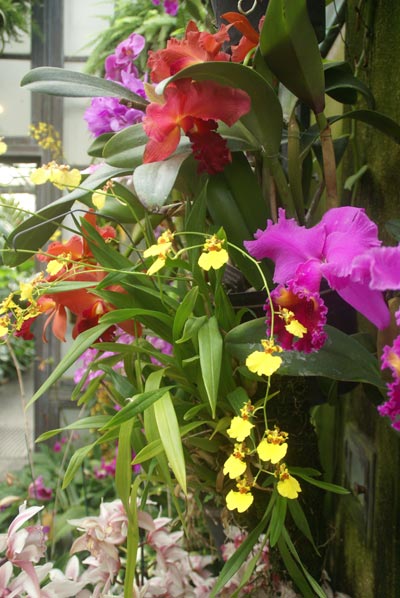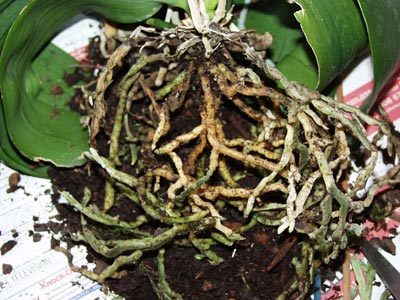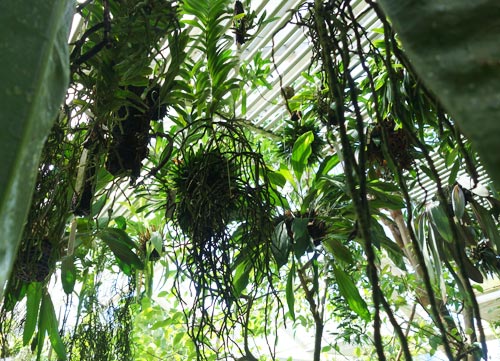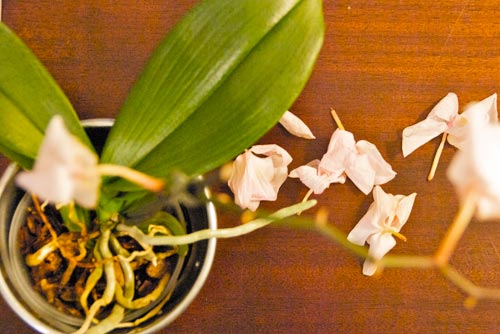

 Care for orchids indoors is easy, as long as there is adequate warmth, light and humidity - photo David Baron
Care for orchids indoors is easy, as long as there is adequate warmth, light and humidity - photo David BaronOrchids are the most wonderful plants, with incredibly beautiful flowers - but if you are here you already know this! Care for orchids indoors, especially the magnificent epiphytic tropical species, is a little different from the care for house plants that are rooted into soil. The common orchids we are talking about: Phalaenopsis, Cattleya, Dendrobium, Vanda are all tropical rainforest orchids, living high up in the forest canopy attached to the branches of trees, holding on by their roots.
 Rainforest orchids growing epiphytically in Malaysia. Photo Bernard Dupont
Rainforest orchids growing epiphytically in Malaysia. Photo Bernard DupontBut as well as epiphytes, there are terrestrial orchids, that grow on the forest floor, and species that root into cracks in rocks, the lithophytic orchids. Growing and planting techniques are a little different to those employed for ground orchid species, specifically in terms of potting and media. Interestingly, terrestrial plants require a lot of light, which would seem unlikely in the darkness of a tropical rainforest. Often these plants take advantage of the temporary clearings created by regular tree-falls in rainforest. Some species survive in more than one of these environmental niches. Cymbidium is semi-terrestrial, but can be found living as a lithophyte, and occasionally as an epiphyte.
As well as the 30,000 different orchid species that occur in the wild, there are thousands more hybrids: crosses between one species and another. The depth and range of orchid flower colors, shapes, patterns and sizes is incredible.
These plants typically take the best characteristics of two varieties. Hybrids are often quite tolerant when it comes to care, and have the most amazing blooms. These are the orchids found at home and garden stores, and generally make the best plants for an inexperienced orchid keeper to start with.
This site has orchid care instructions for many regularly available species: learn more about the ideal night and day temperatures, humidity, the best potting media, the recommended habits when it comes to watering and feeding, how to provide your orchids with sufficient amounts of light without scorching them, and finally when and how to re-pot each orchid. Read more about care for orchids indoors, and look for your plant in 'Orchid Types' above.
The best way to care for many orchids is to be aware of their needs; a close examination of the plants roots not only gives an idea of the plants general health, but most importantly tells us when the plant is ready to be watered. Furthermore, many epiphytic orchids (Phalaenopsis are a great example) have photosynthetic roots; i.e. they are a capable of photosynthesis, just like the leaves. For this reason, a clear orchid pot is the preferred choice for many orchid species. Slots help keep the roots ventilated, aswell as let water drain away after watering, and light can penetrate the plastic. Some species, such as members of the genus Vanda prefer to be planted in a basket with no media at all. Orchids generally prefer a smaller pot, so their roots can be quite compact. Taller plants (for example Dendrobium) may need a weightier pot to maintain balance. Clay pots, perhaps with some stones at the bottom are a good choice for these species.
Epiphytes grow on tree trunks, so naturally medium and coarse grade bark chips are the perfect media for roots to cling to; they don't absorb much water, so prevent water-logging, and can be packed loosely enough to give allow some ventilation. Media should never be compact. Clay leca pebbles are very useful, and can be added to the bark, giving great drainage, and storing some water without waterlogging. In some hotter, drier climates, small amounts of sphagnum moss can be added to help maintain humidity.
Of course many epiphytic orchids need no media at all, and can instead be mounted on tree fern panels (e.g. Dendrobium) or placed in special slatted baskets (e.g. Vanda). Plants kept in this way will need considerably more frequent watering than potted orchids, typically 1-2 times daily.
Terrestrial orchids can be potted in a loose mix of coco fiber, peat, sphagnum moss and perlite. Some charcoal can be added to keep the media fresher for longer.
 Learning how to repot an orchid is not hard - and it allows us to check the health of orchid roots. Healthy roots will be fairly solid and of similar thickness throughout. This plant clearly has healthy roots and will not need much root trimming
Learning how to repot an orchid is not hard - and it allows us to check the health of orchid roots. Healthy roots will be fairly solid and of similar thickness throughout. This plant clearly has healthy roots and will not need much root trimmingRepotting orchids is not at all difficult, but it is perhaps the one aspect of orchid care that worries beginners the most. Generally they should be repotted about every two years, though they can be repotted at any time, especially if the media has an outbreak of mould. Generally the best time is in the spring after flowers have dropped. Over time, bark chip media breaks down as it starts to decay; the resultant media gradually gets compacted, developing anaerobic regions, whilst miccro-organisms compete with the plant for nutrients. At this point it is a very good idea to repot; orchid plant breeders will often repot any new plant as soon as they receive it, but generally once every two years is quite sufficient. Another reason to repot is when splitting larger plants, or giving a large plant a little more room to grow. The method is quite simple, and should only take about 20 minutes or so.
For more details and images, see the page how to repot an orchid
 Orchid care with regard watering and humidity is most easily achieved when the plant roots are well ventilated, as is the case with these plants hanging in the Brooklyn Botanic Garden, NYC. Photo Allison Meier
Orchid care with regard watering and humidity is most easily achieved when the plant roots are well ventilated, as is the case with these plants hanging in the Brooklyn Botanic Garden, NYC. Photo Allison MeierWatering orchids indoors is not an exact science, and will depend heavily on local climatic conditions, and whether the plant is in a growth period. But it is not hard to take care of potted orchids watering requirements. Simply have a feel of the media. Unless it is almost dry a few inches down, the plant will not need watering. Have a look at the roots. Epiphytic orchids will tell you when they want to be watered. If they are green, it is a sure sign the plant is not thirsty. If the roots are silver, however, the plant can be watered. Simply pour a small jug of water through the pot. Water should ideally be around ambient temperature, not too hot or too cold. It does not matter how much water you pour through, as the water will immediately drain away. In the home, this is best done over a sink, as the many slots and holes in the orchid pot will let all water escape, leaving the moist media, and hopefully no water-logging. A really dry plant can be allowed to sit in a container of water to have a good soak. However once watered, orchid pots should never sit in a dish of water. If plants are hung, for example in a greenhouse, they may be simply watered in situ where they should drain perfectly. At this point, aerial roots can also be misted, turning immediately from silver to green as they absorb the moisture. In really hot conditions, and especially for larger plants, your orchid may occasionally require more water. The orchid can be placed in a container of water, pot-deep, for 5-10 minutes to have a really good soak. This is fine, as long as the media drains adequately on it's removal.
Plants grown without media (for example Vanda in their baskets, or small Dendrobium grown on tree fern panels) will require watering daily, sometimes twice daily in hot weather.
Orchid watering problems that can occur are mainly when the plant is not watered for an excessive period, or if the pot does not drain completely. Proper care for orchids demands close attention to watering. Most orchid owners will only need to water twice each week in summer and once each week in winter.
Special orchid hygrometers, designed for use with bark chips do exist, and while of some use, it is far better (and cheaper) to learn how to 'read' your plant yourself.
 Photo Ben Haeringer
Photo Ben HaeringerCorrect potted orchid care, to a large extent, revolves around watering and humidity. Even when not raining, tropical rainforests are humid habitats, and providing your plants with a similarly humid environment is therefore recommended; but if you want to provide the best orchid care, you have to allow enough moisture to keep the plant hydrated, but not so much as to cause any leaf rot or mould. The recommended daytime humidity for orchids is 50-70 percent, not something easy to achieve in many parts of the world. A greenhouse with misting equipment is one solution, and many orchid growers from hot climates may mist their plants during the afternoon, evening or even night-time, but if you are a beginner orchid keeper you should ideally limit watering, spraying and damping down to the morning or mid-day when there is plenty of sunlight and higher temperatures. As the temperature drops during the afternoon and evening, condensation will occur and if you add a lot of extra moisture during this period your orchid will become soaked in condensing water. Droplets produces by excessive condensation will increase the risk of rotting and mould growth.
A simpler solution, and one perfect for use in the home, is a humidity tray, which can provide constant increased humidity, directly above it, with no danger of over-wetting, and a greater margin of safety if misting or watering is missed. It protects any surface the plant is placed on, like a saucer, but allows complete draining, prevent over-wet media. You can make your own pebble tray, that will do the same job, but the commercially available trays are cheap, attractive and less prone to algal outbreaks, so in turn require less maintenance.
To properly look after orchids indoors, one must remember the natural habitat of many epiphytes in the wild, is the humid tropical cloud forest, such as seen here in this wonderful picture of the Santa Elena reserve in Costa Rica. Misty!
Orchid feeding is another issue that can cause concern new orchid owners. Again it is best to consider what happens to the orchid in it's natural environment. In the rainforest, the epiphytic orchids are occasionally littered with general rainforest detritus, both plant matter (leaves, seed pods, fruit), and animal matter (animal and plant droppings, dead insects etc) - all fallen, or washed down from, the canopy above. Larger fragments may get caught amongst the stems and roots. As these decay, nutrients are released that the orchid can absorb, primarily with it's roots.
So how much fertilizer an epiphyte receives in nature is clearly somewhat hit and miss. Literally. Clearly, failing to fertilize your orchid occasionally is not a big deal. But for optimal care, orchids indoors need to be fertilized on a regular basis. Orchid foods are generally liquids, the specialist orchid fertilizers, given regularly in low concentrations have all the nutrients required for good growth and continual flowering. Rather than giving a month's dose in one go, better to give a 0.25x concentration weekly. Some people prefer a 0.5x concentration every two weeks. In any case, over fertilizing can damage plant roots, so if in doubt, underfeed rather than overfeed.
Plant fertilizers are not all the same of course. Most will quote a N-P-K number, representing the proportions of three key nutrients: nitrogen, phosphorus, and potassium. The best orchid food will have a higher nitrogen level during the growth phase (maybe 30-10-10 during spring to midsummer) and a higher phosphorus level during flowering (maybe 11-35-15 from late summer to fall). In truth, many people have great success with year-round feeding of just high-nitrogen, or even balanced (20-20-20) orchid fertilizers, however the use of a phosphorus rich formula can greatly enhance flower numbers and size.
Orchid lighting requirements differ from species to species, but in general the epiphytic types live in trees, so they have considerably more brightness than plants on the forest floor, but are partially shaded from the suns rays by leaves above. Take care - orchids indoors need light, but to some degree or another must be protected from the burning heat of the sun. In the rainforest, the warmth of the sun is tempered by breeze and evaporative cooling. But in our homes, with no breeze and less moisture (so no cooling by the evaporation of water), summer sun can over-warm the leaves and eventually cause yellowing and permanent damage. But an orchid positioned too far from a window may not flower. Getting the optimal light level for orchids is not always simple.
There are a few general rules that tell you whether your orchid is getting sufficient light. Leaves should be bright green. Dark green leaves are not getting enough light, yellowing leaves are getting too much.
Orchids are often described as having low-light, medium-light or high-light requirements. But in truth, these distinct categories are a bit of an approximation, as not all orchids described as low light, or high light, for example, have the same requirements. All orchids like bright lighting, but it is their ability to tolerate the heat of direct sun that determines whether orchids are low, mid or high heat.
Low-light level orchids are more susceptible to leaf burn. Species such as Paphiopedilum, Phalaenopsis, Miltoniopsis and Oncidium still need bright light, but should not experience direct sunlight except perhaps for short time at sunrise or sunset. In strong light conditions, these plants can be positioned further from windows, or heat can be reduced by placing a fine screen or net curtain between the window and the plant.
Medium light orchids, such as Oncidium and Miltonia do enjoy some direct sunlight hitting their leaves, but not the hottest direct mid day beams. Occasional repositioning of these plants may be a good idea, depending on your local conditions. These species can also enjoy a little extra light from an artificial souce.
High light level orchid species, Vanda, Cattleya and Dendrobium, enjoy more sun still, but again, not the strongest mid day sun. These species are least prone to leaf burn, but, depending on your local conditions, can tolerate full sun for much of the year. Good species for very bright conditions. Grow lights might be required in lower light environments.
An artificial grow light is an excellent means of giving a plant extra light without the danger of leaf burn. Cool LED orchid grow lights are perfect, as long as leaves do not touch the bulb. These can really help an orchid in a situation where it receives insufficient lighting.
In general, typical home temperatures are adequate for most orchids, especially the species typically seen on home and garden stores. These plants need a day / night temperature change, but one that also occurs in our homes. Orchids generally should not be kept in environments with a constant day / night temperature. In general, orchids are fairly adaptable, and as long as they do not experience too sudden extremes, should do fine in most typical conditions. Orchid species kept by specialist growers may need cooler or warmer conditions, depending on their natural habitats, If you intend to grow something unusual, it is definitely worth checking it's temperature requirements beforehand. Some easy to keep varieties (most notably 'soft cane' Dendrobium like D. nobile) will actually need a brief period of cooler weather in the late autumn to encourage flowering the following season.
A flowering orchid is truly a thing to behold; the explosion of colors a magnificent sight. Orchids do have attractive foliage, but for most people, it is the flowers that hold the most appeal. But what to do with orchids after flowers fall off? Orchids bloom every year, sometimes more than once. A new flower spike will eventually grow, and this is one of the most exciting aspects of keeping the plants.
 With a little care, orchids will grow new flower spikes year after year. Photo David Huang
With a little care, orchids will grow new flower spikes year after year. Photo David HuangThis is another orchid care question that is often asked . Once the flowers have dropped from a flower spike, what should one do? The old spike can be left in place, but it will eventually shrivel away, so many people just cut them off, a little above where the spike meets the leaves. In some cases you can cut the spike a little higher, 2-3 nodes above where it meets the leaf, and it may re-flower. This uses a lot of the plants energy required for leaf and root growth, so should only be attempted on particularly healthy specimens. After flowering is generally a good time to repot - if a repot is due.
Orchid species are all very different, and it is not easy to generalize how often they will flower. Some plants may have a resting period after flowering, where all processes slow down. No doubt this replicates how a wild orchid deals with the dry season in it's natural environment. A resting orchid should have watering reduced to once per week, and feeding to once per month. After two-three months, growth resumes and watering and fertilization can continue as normal.
Orchid lighting is the main cause of an orchid that will not bloom. The plant should be moved to a brighter position, or have an artificial light source installed to add additional brightness. The number one rule of orchid care is to examine the plant. Dark green leaves are a sign of a plant getting insufficient light.
Another reason an orchid will not flower is if it is not healthy. Is a repot long overdue? Are the roots healthy? Is the orchid being allowed to sit in too much moisture. Correct orchid maintenance is obviously essential for a healthy plant to produce blooms.
For further articles on orchid care indoors and outside, see the articles listed in the menu above. Be sure to read the specific pages about each genera. But remember there is an exception to just about every orchid rule, so learn to read your plant. It will tell you when it is or is not happy!
Some of the interesting, rare and not-so-rare orchids for sale